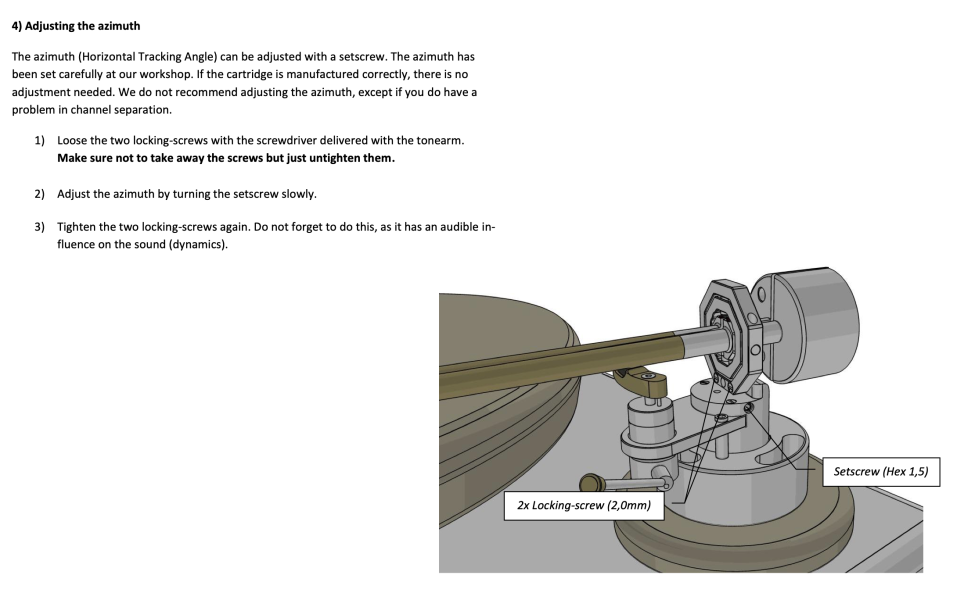I have demonstrated at shows and in my listening studio the Thales Simplicity II against other top tonearms when the Simplicity came out in 2010 and it certainly didn't sound mediocre. As I have said previously it requires very careful set up. Back then only the Schroder Reference sounded superior.I’ll explain why I find the Thales arms mediocre. In fact, when something sounds mediocre, it just does—but I’ll outline the reasons behind that impression.
First of all, Thales (or more specifically, tangential pivoted tonearms) attempt to solve a tracking-error problem that was never a real issue to begin with. They offer a “solution” at the expense of rigidity. There are so many ball bearings in the mechanism of Thales that it’s impossible for the arm to remain truly rigid. You can see this clearly when playing a resonance test track. You don’t need any analyzer—the arm visibly cannot remain the cartridge stable. By the way, the Statement (5 or 6 different arms) performs better than the Simplicity II (5 arms) but still lacks proper rigidity.
When there are that many joints and bearings, you cannot avoid backlash. Even if you believe you have eliminated it, the “sponge effect” of the bearings and joints remains. This kills dynamics and drains the life out of the music.
The internal tonearm wiring is also problematic. It sounds harsh and tipped up in the highs. My guess is that they chose that cable to compensate for the arm’s inherently dull and lifeless performance—but trying to fix one flaw with another is not a real solution. Additionally, the hole where the cable enters the arm base is bare metal, which gradually scrapes the insulation and leads to hum over time. That is a design flaw.
More importantly, there is no adjustable anti-skating. It is preset at the factory and rarely matches the cartridge being used. In my experience, the value isn’t even consistent from sample to sample and is typically far too high, bending the cantilever and creating more tracking error than the tangential geometry supposedly solves in the first place.
Cartridge setup is also more restrictive. You are forced to use their jig, and your entire setup depends on multiple assumptions: correct P2S distance, correct jig alignment, etc. But this is not the best method. The best way is to visually verify stylus alignment on a protractor with proper VTF applied. You cannot properly do that with Thales arms. Beyond overhang, there is an even more critical factor: zenith error. You cannot reliably check stylus/cantilever zenith with the Thales system. Even if you manage it, you still have non defeat-able anti-skating working against you. In the end, the lack of proper zenith alignment probably introduces more tracking error than the tangential geometry corrects.
I can go on, but I think that’s enough for now.
It is well known that parallel tracking tonearms, just like the cutting lathe where the record was cut, does eleminate any tracing or tracking distortion that a pivoted tonearm gives no matter how long the armtube is, and this what Thales has tried to achieve. To say the tonearm armtubes are not rigid is laughable. It is a very rigid structure due the the headshell bridge and the bearing bridge within the tonearm mounting pivot providing a 4 point rigid structure. Also, there is almost zero play and backlash in the bearings as these come from the watchmaking industry. Having compared this tonearm with other pivoted arms, gimbal and uni-pivoted types, the "bearing play" is less with the Thales than with other tonearms.
I do agree that the wiring coming out of the arm in through the base is a potential weak spot but when I installed these on customer turntables I used some fine butyl rubber sleeves that slide up the tonearm wiring and through the base and solved this potential issue. Any competent installer should be able to do this when installing these arms. The wiring I might add was of a very high quality and I had absolutely no issues in the 6 years installing these tonearms.
The jigs provided by Thales provide accurate stylus to pivot distance, also cartridge alignment too and makes this job relatively easy. I have check the geometry with my Acoustical systems Smart Tractor and found the Thales system to be accurate.
There is cartridge azimuth adjustment, not sure why you call it zenith. It's normally referred to as HTA or Horizontal Tracking Angle or Cartridge Azimuth. I suggest you read the manual. I have included a clip of the relevant section below.
As I have said previously, the Thales Simplicity II is a very good tonearm especially when it came out in 2010. There was very few tonearms around at that time that could provide this level of performance. I am sure today, well I would hope by today, that tonearm design has improved and sound quality has moved on a little further...

Last edited:







